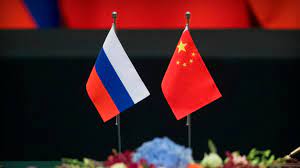Kamal Uddin Majumder
The third joint naval patrol between China and Russia, which is said to have reached international waters close to Alaska last week, has riled up the US media, which has dubbed the mission “highly provocative”. The Wall Street Journal (WSJ) reported that 11 Chinese and Russian ships approached the Aleutian Islands but later departed without entering US territorial waters. A P-8 maritime patrol plane and four US destroyers followed the combined naval forces of China and Russia, according to the report.
China made the declaration of joint patrol earlier, which is a prudent action to avoid misjudgment, demonstrating transparency and confidence. On July 26, China’s Ministry of National Defense declared that, in accordance with an annual cooperation schedule between the Chinese and Russian militaries, the two countries’ navies would hold a joint naval patrol in West and North Pacific waters. Despite China’s clarification that the operation is not targeted against any third party and has nothing to do with the current international and regional situation, the US has become overtly concerned about the Russia-US voyage, given the proximity of the Bering Sea to Alaska. However, it reveals the US’ double standard in that it frequently deploys warships and aircrafts to the South China Sea and the Taiwan Strait for so-called freedom of navigation operations but does not accept other nations’ military presence close to them.
It is ironic that US warships frequently violate Chinese territorial waters in the South China Sea under the name of freedom of navigation, but becomes alarmed when China and Russia exercise their legal patrol in international waters without intruding into the US waters. Unsurprisingly, the US won’t consider it “freedom of navigation” if the Chinese or Russian navy passes via the Panama Canal or the Caribbean Sea. So, under what legal framework do they consider the South China Sea operations of their warships to be free navigation? The China-Russia joint patrol has not intruded on America’s waters. So how can it be considered “provocation” or “aggression”? However, Brent Sadler, a senior research scientist at the Heritage Foundation, ridiculously referred to it as “highly provocative”. What gives the US the right to criticize China and Russia, who have been conducting the patrol in accordance with international law?
The latest China-Russia joint patrol came amid rising tensions in the South China Sea and the Indo-Pacific area, where the US has increased combat preparedness, rallied allies and partners, and repeatedly stoked unrest and instability over the past few years to alter the status quo. Even though NATO’s eastward expansion has already resulted in the Ukraine crisis, Japan’s decision to create NATO’s first liaison office in Asia last month sparked widespread concerns about NATO’s future expansion into the Asia-Pacific area.
The Bering Sea and other international seas in the North Pacific are crucial because they can be used as gateways to the Arctic. Similarly, the Arctic shipping routes could become important passages for civilian ships to conduct economic activities as a result of climate change. The China-Russia joint patrol is an encouraging development that contributes to preserving regional stability and security along these crucial strategic corridors in the Asia-Pacific, which the US wishes to control due to its hegemonic intentions.
From a military perspective, the China-Russia joint sea patrol in West and North Pacific waters is of vital significance for both countries. The level of strategic mutual confidence between them is reflected in the latest naval patrol, which significantly strengthened the long-standing friendship between the two militaries. It demonstrated how firmly China and Russia are cooperating militarily. Russia and China are both aware of the growing military alliance akin to NATO in the Asia-Pacific area, which poses a severe threat to regional peace. The combined patrol shows that China and Russia remain the region’s pillars of peace and stability. The two nations’ shared concern for the strategic stability of the region, as well as their capabilities to uphold peace and security in the region were all reflected in their joint patrol.
Most importantly, the joint patrol also makes it very evident to the US that the world is moving toward multipolarity and that in the years to come, US hegemonic interests will be subject to increasing scrutiny and challenges. As long as China and Russia work strategically together and take on obstacles together, they can provide effective deterrence, put together a joint force to handle particular issues, fend off attempts to repress the two nations and restrain US international wrongdoing. In sum, it is expected that despite Biden’s efforts to ease tensions with Beijing, China and Russia’s strategic cooperation must be maintained, and such joint patrols should be conducted more regularly in a normalized manner in order to withstand escalating US-led provocations in the area.
The China Daily







